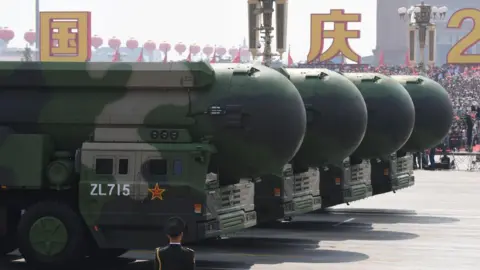By Kelly Ng & Frances Mao, BBC news
China says it carried out a rare test-firing of an intercontinental ballistic missile (ICBM) into international waters, sparking protests from neighbouring countries.


The launch on Wednesday – its first in more than 40 years – was “routine” and not aimed at any country or target, according to Beijing. Chinese media reported the government also gave “relevant countries” notice.
But Japan said it had not received a warning and expressed concerns, along with Australia and New Zealand.
The launch contributes to tensions across the Indo-Pacific region, with analysts saying it highlights China’s increased long-range nuclear capabilities.
The US warned last year that China has built up its nuclear arsenal as part of a defence upgrade. An intercontinental ballistic missile can travel more 5,500km – putting China within striking range of the US mainland and Hawaii.
But Beijing’s arsenal is still estimated at less than a fifth of the size of the US’s and Russia’s, and China has long maintained that its nuclear maintainance is only about deterrence.
On Wednesday, Beijing announced that the long-range missile was fired at 08:44 local time (04:44 GMT). It carried a dummy warhead and landed in the designated area – believed to be in the South Pacific.
Beijing’s defence ministry added the test launch was “routine” and part of its “annual training”.
But analysts said China was last known to have test-fired an ICBM internationally in the 1980s. Typically, it tests internally – having previously fired ICBMs west into the Taklamakan Desert in the Xinjiang region.
“This sort of testing is not unusual for other countries, including the United States, but is for China,” nuclear missile analyst Ankit Panda told the BBC.
China’s “ongoing nuclear modernisation” already has resulted in substantial changes, he said. This launch now appears to also show a change in its approach.
It has sparked immediate reaction from other countries. Japan said it had received “no notice” and expressed “serious concern” about Beijing’s military build-up.
Meanwhile, Australia said the action was “destabilising and raises the risk of miscalculation in the region” and that it had sought “an explanation” from Beijing. New Zealand called it “an unwelcome and concerning development”.
Mr Panda said he doesn’t believe China’s actions were primarily designed to send a political message – “but no doubt this will be a stark reminder to the region and to the US that nuclear dynamics in Asia are quickly changing”.
Other analysts went further, saying it was another wake-up call for the US and its allies in the region.
“To Washington, the message is that direct intervention in a conflict across the Taiwan Strait would involve the American homeland being vulnerable to attack,” said Leif-Eric Easley, an international relations professor at Ewha Women’s University in South Korea.
For US allies in Asia, the “provocative test… demonstrates China’s capabilities to fight on multiple fronts simultaneously,” he added.
“Timing is everything,” Drew Thompson, a senior fellow at the S. Rajaratnam School of International Studies in Singapore, wrote on X.
“[China’s] statement claims the launch does not target any country, but there are high-levels of tension between China and Japan, Philippines, and of course perpetual tension with Taiwan.”
While the relationship between Beijing and Washington has improved in the past year, China’s increasing assertiveness in the region remains a sticking point. Tensions have ramped up between China and the Philippines as their ships have repeatedly collided in disputed waters.
Last month, Japan scrambled fighter jets after it accused a Chinese spy plane of breaching its air space, a move that it called “utterly unacceptable”.
Beijing’s relationship with self-governed Taiwan is another source of strain.
Taiwan’s defence ministry said earlier on Wednesday that China had been carrying out “intensive” missile firing and other drills recently. The same statement noted that it detected 23 Chinese military aircraft operating around Taiwan on “long-range missions”.
Beijing routinely sends ships and aircraft into Taiwanese waters and airspace, called a “greyzone warfare” tactic meant to normalise the incursions.
In July, China suspended its nuclear arms control talks with Washington, in retaliation for the US’s continued arms sales to Taiwan.
The US last year warned of China’s nuclear modernisation although its numbers still far short of Washington’s. The Pentagon estimated that China has more than 500 operational nuclear warheads in its arsenal, of which approximately 350 are ICBMs.
The report projected that China will reach over 1,000 warheads by 2030; the US and Russia each say they possess more than 5,000 warheads.
There also have been conflicts around the Chinese military’s Rocket Force, the elite unit managing its nuclear arsenal. An aggressive anti-corruption campaign led to the firing of two of its leaders last year.







